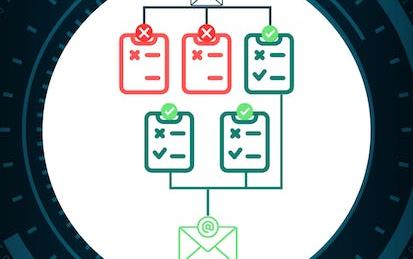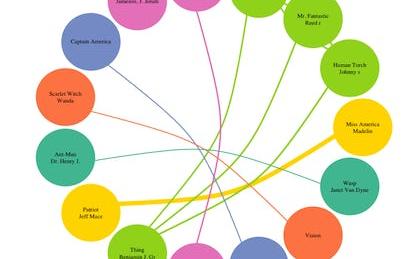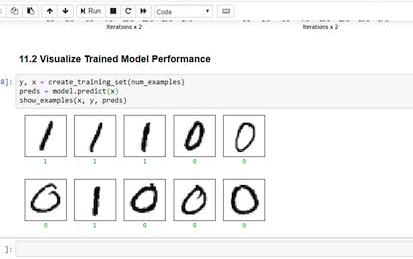

Our Courses

Algebra: Elementary to Advanced - Polynomials and Roots
This course is the final course in a three part algebra sequence, In this course, students extend their knowledge of more advanced functions, and apply and model them using both algebraic and geometric techniques. This course enables students to make logical deductions and arrive at reasonable conclusions. Such skills are crucial in today's world. Knowing how to analyze quantitative information for the purpose of making decisions, judgments, and predictions is essential for understanding many important social and political issues.
-
Course by

-
 Self Paced
Self Paced
-
 9 hours
9 hours
-
 English
English

Create Animated Social Media Posts using Canva
By the end of this project, you will learn how to create an animated social media post using the free version of Canva. Animated social media posts are great tools for drawing the attention of your followers and customers to the information you are aiming to share. We can use Canva to complete this project because it provides all the tools you need to create an organized and visually appealing product while offering a variety of options for sharing and collaboration.
-
Course by

-
 Self Paced
Self Paced
-
 3 hours
3 hours
-
 English
English

Flight Mechanics - Anemobarometry
This course focuses on the physics of the atmosphere and its consequences on speed and altitude measurements. At the end of this course, you will understand precisely the meaning of the speed and altitude indication available to the pilot of an airplane. You will understand the difference between standard and actual atmosphere and be able to perform basic altitude and speed correction computations. You will understand why jet airliners need to be pressurized, or why a clogged Pitot tube can mislead a pilot. Although some math equations are used from time to time to justify certain results.
-
Course by

-
 Self Paced
Self Paced
-
 7 hours
7 hours
-
 English
English

Introduction to Bayesian Statistics
The objective of this course is to introduce Computational Statistics to aspiring or new data scientists. The attendees will start off by learning the basics of probability, Bayesian modeling and inference. This will be the first course in a specialization of three courses .Python and Jupyter notebooks will be used throughout this course to illustrate and perform Bayesian modeling. The course website is located at https://sjster.github.io/introduction_to_computational_statistics/docs/index.html.
-
Course by

-
 Self Paced
Self Paced
-
 13 hours
13 hours
-
 English
English

Machine Learning Using SAS Viya
This course covers the theoretical foundation for different techniques associated with supervised machine learning models. In addition, a business case study is defined to guide participants through all steps of the analytical life cycle, from problem understanding to model deployment, through data preparation, feature selection, model training and validation, and model assessment. A series of demonstrations and exercises is used to reinforce the concepts and the analytical approach to solving business problems.
-
Course by

-
 Self Paced
Self Paced
-
 34 hours
34 hours
-
 English
English

Process Forms with AI Model in Power Automate
Do you receive an extraordinary amount of job application emails every day? Moreover, do you have the time to screen and read each job applicant’s email? How can you efficiently filter all candidate emails and forward qualified applicants to hiring committees? In this beginner-level guided project "Process Forms with AI Model in Power Automate", we will use a pre-created job application form and create a model that will extract data from the form. We will then train the model with a couple of patterns, and create a flow that will use the model when candidate emails arrive.
-
Course by

-
 Self Paced
Self Paced
-
 2 hours
2 hours
-
 English
English

Linear SVM Classification(Soft Margin) -using Scikit Learn
Linear SVM Classification(Soft Margin) -using Scikit Learn
-
Course by

-
 Self Paced
Self Paced
-
 3 hours
3 hours
-
 English
English

Nuts and Bolts of U.S. Immigration Law
This course begins by exploring short term entry and long term entry into the United States. We will cover the various means of short term entry and long term entry, as well as the general application processes. We will also examine exclusion and deportation in the United States. In particular, we will discuss how and why individuals may not be admitted into the United States and possible reasons for deportation or removal. Lastly, we will cover the process of how to become a United States citizen and the various requirements for naturalization.
-
Course by

-
 Self Paced
Self Paced
-
 10 hours
10 hours
-
 English
English

Managing Threat Intelligence with Cortex XSOAR
This is a self-paced lab that takes place in the Google Cloud console. Work on a real life threat hunting scenario to learn how to successfully manage your threat intelligence data with Cortex XSOAR TIM and automate response actions using threat intel management playbooks.
-
Course by

-
 Self Paced
Self Paced
-
 1 hour
1 hour
-
 English
English

Causes of Racial Inequity in Healthcare
The second course of the Addressing Racial Health Inequity in Healthcare specialization you will journey through a survey of critical drivers of racial inequities in healthcare. These critical drivers need to be known in order to implement interventions that can achieve health equity. You will explore issues that arise around the financing of healthcare in the U.S, and how this system enables race-based disparities. You will then explore the multiple dimensions of access to care, and how various dimensions perpetuate racial inequities in care.
-
Course by

-
 Self Paced
Self Paced
-
 15 hours
15 hours
-
 English
English

Data Manipulation at Scale: Systems and Algorithms
Data analysis has replaced data acquisition as the bottleneck to evidence-based decision making --- we are drowning in it. Extracting knowledge from large, heterogeneous, and noisy datasets requires not only powerful computing resources, but the programming abstractions to use them effectively.
-
Course by

-
 Self Paced
Self Paced
-
 20 hours
20 hours
-
 English
English

Object-Oriented C++: Inheritance and Encapsulation
Code and run your first C++ program in minutes without installing anything! This course is designed for learners with limited coding experience, providing a solid foundation of not just C++, but core Computer Science topics that can be transferred to other languages. The modules in this course cover inheritance, encapsulation, polymorphism, and other object-related topics. Completion of the prior 3 courses in this specialization is recommended. To allow for a truly hands-on, self-paced learning experience, this course is video-free.
-
Course by

-
 Self Paced
Self Paced
-
 9 hours
9 hours
-
 English
English

Non-Equilibrium Applications of Statistical Thermodynamics
Course 5 of Statistical Thermodynamics explores three different applications of non-equilibrium statistical thermodynamics. The first is the transport behavior of ideal gases, with some discussion of transport in dense gases and liquids. It starts with simple estimates of the transport properties of an ideas gas. It then introduces the Boltzmann Equation and describes the Chapman-Enskog solution of that equation in order to obtain the transport properties. It closes with a discussion of practical sources of transport properties.
-
Course by

-
 Self Paced
Self Paced
-
 8 hours
8 hours
-
 English
English

Cloud Top Ten Risks
After completing the course, the student should be able to do the following: ● Associate lists of OWASP Top Ten Risks with major cloud cybersecurity risks. ● Apply appropriate cryptographic techniques to secure authentication mechanisms and cloud data. ● Identify the most effective strategies for resisting injection attacks, cross-site scripting attacks, and object deserialization attacks. ● Assess strategies to address risks posed by administrative failures, including misconfiguration, broken access control, vulnerable software components, and security monitoring.
-
Course by

-
 Self Paced
Self Paced
-
 9 hours
9 hours
-
 English
English

Data Platform, Cloud Networking and AI in the Cloud
The Data Platform course aims to establish a strong foundation, and working knowledge of the fundamentals of data, including data mechanics, databases, and other foundational elements of data processing. This course will drill into the specific data management elements including relational taxonomy of data, data lifecycle and fundamentals databases and data processing and analysis. The course also covers the relevance of IA with respect to data in the cloud.
-
Course by

-
 Self Paced
Self Paced
-
 7 hours
7 hours
-
 English
English

Visualizing static networks with R
In daily life, our connections with family and friends form our social networks.
-
Course by

-
 Self Paced
Self Paced
-
 4 hours
4 hours
-
 English
English

Developments of structural dynamics
This course is devoted to the dynamic implementation of continuous structural elements vs discrete models. The matrix representation and implicit solution of Lagrange’s equation are at the heart of this approach, in the framework of conservative structural systems, with Gaussian modes.
-
Course by

-
 Self Paced
Self Paced
-
 10 hours
10 hours
-
 English
English

Guide Project 2: SCI – Sentinel.
Creating a Microsoft Sentinel workspace.…
-
Course by

-
 Self Paced
Self Paced
-
 English
English

Simulation of KANBAN Production Control Using R Simmer
Understand Kanban Production Control Model Discrete Event Simulations Using R Simmer Capture Simulation Data, Plot Charts & Interpret Results
-
Course by

-
 Self Paced
Self Paced
-
 3 hours
3 hours
-
 English
English

Performing Real Time Analytics with Stream Analytics
In this 1-hour long project-based course, you will learn how to (stream and process events with Azure Stream Analytics, data Ingestion with Event Hubs, processing data with Stream Analytics Jobs).
-
Course by

-
 Self Paced
Self Paced
-
 3 hours
3 hours
-
 English
English

Simulation Skills: This is Your Brain on the Future
Do you want to learn how to simulate the future more creatively and more effectively? This course is for you. Humans are the only living creatures with the ability to think about and make plans for the long- term future. Even so, our brains don’t always make it easy. Over the past decade, scientists have discovered a number of neurological “road blocks” to effective futures thinking. These glitches in the brain make it harder for us to accurately predict how we’ll feel and what we’re likely to do, when a particular future arrives.
-
Course by

-
 Self Paced
Self Paced
-
 13 hours
13 hours
-
 English
English

Introduction to Web Applications
Students start by learning about the HyperText Markup Language (HTML) and basic rules for creating compliant HTML. They learn tags for creating web pages and formatting text on the page including lists and special characters. Students will learn how to embed images, video and audio in web pages and format information in tables. They will learn to create hyperlinks, and to use text and images for hyperlinks including creating image maps. Students will also create HTML forms to collect user information.
-
Course by

-
 Self Paced
Self Paced
-
 21 hours
21 hours
-
 English
English

Visualizing & Communicating Results in Python with Jupyter
Code and run your first Python program in minutes without installing anything! This course is designed for learners with limited coding experience, providing a foundation for presenting data using visualization tools in Jupyter Notebook. This course helps learners describe and make inferences from data, and better communicate and present data. The modules in this course will cover a wide range of visualizations which allow you to illustrate and compare the composition of the dataset, determine the distribution of the dataset, and visualize complex data such as geographically-based data.
-
Course by

-
 Self Paced
Self Paced
-
 11 hours
11 hours
-
 English
English

Logistic Regression with Python and Numpy
Welcome to this project-based course on Logistic with NumPy and Python.
-
Course by

-
 Self Paced
Self Paced
-
 4 hours
4 hours
-
 English
English

Creating a Data Warehouse Through Joins and Unions
This is a self-paced lab that takes place in the Google Cloud console. This lab focuses on how to create new reporting tables using SQL JOINS and UNIONs.
-
Course by

-
 Self Paced
Self Paced
-
 1 hour
1 hour
-
 English
English



